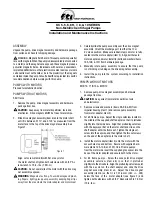
PAD-L
Applied Operation
4-33
4.
Connect a battery or capacitor across the output terminals as shown in
Fig. 4-19.
WARNING
•
Connect the unit and battery to the same polarity. In addition to
damaging the unit, connecting them to opposite polarities may
result in battery failure.
CAUTION
•
When a charged battery is connected to the unit, if the POWER
switch of the unit is OFF or the output voltage of the unit is lower
than the charged battery voltage, a current of several hundred mA
flows into the unit. If this current presents problems, connect a
reverse-current prevention diode (D
RP
) to the circuit in series, as
shown in Fig. 4-19.
When using PAD16-100L, PAD35-200L, PAD60-120L, or PAD110-
60L, note that a charged current can flow abruptly from the battery
into an electrolytic capacitor within the unit, which may
deteriorate and eventually blow the output fuse.
When any of the power supplies noted above is used in this
operation, connect D
RP
or adjust the output voltage of the power
supply equal to the battery voltage.
•
The remote sensing function cannot be used when the D
RP
is
connected.
•
To protect the power supply and the load, select D
RP
that meets
the following requirements:
1. Reverse-voltage tolerance is at least two times the rated
output voltage of the power supply.
2. Forward current capacity is three to ten times the rated
output current of the power supply.
3. A diode with small loss
•
Be sure to take account of heat generation from D
RP
. D
RP
may
burn unless adequately dissipated.
5.
Recheck that the connections.
PAD-L
S: External contact
D
RP
: Reverse-current prevention diode
D
RP
S
+
+
–
–
+
–
Battery
Capacitor
Fig. 4-19
Constant current charge circuit
Summary of Contents for PAD-L III Series
Page 4: ...II PAD L...
Page 16: ...P 6 Preface PAD L...
Page 40: ...2 12 Precautions and Preparations for Use PAD L...
Page 86: ...4 34 Applied Operation PAD L...
Page 98: ...5 12 Names and Functions of Controls PAD L...
Page 130: ...7 14 Specifications PAD L...
















































